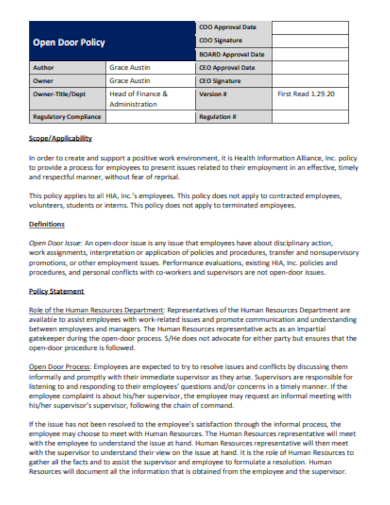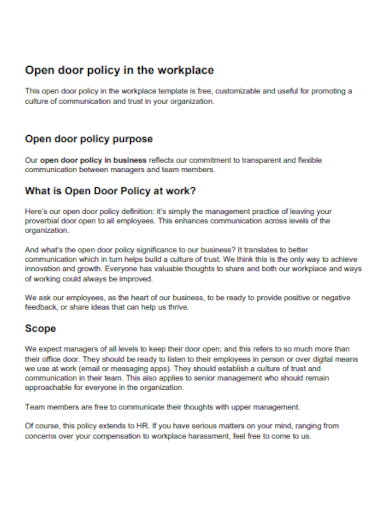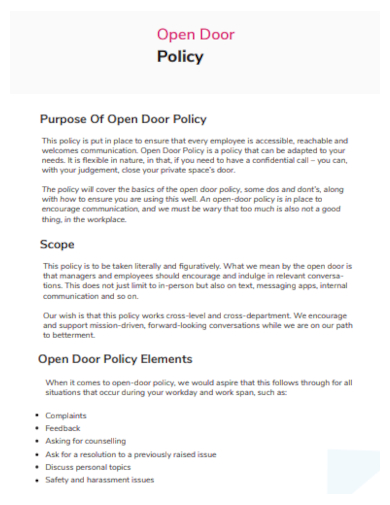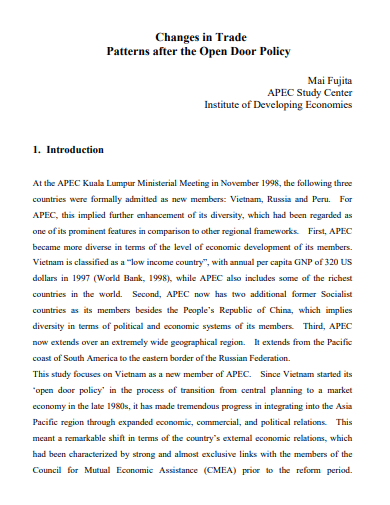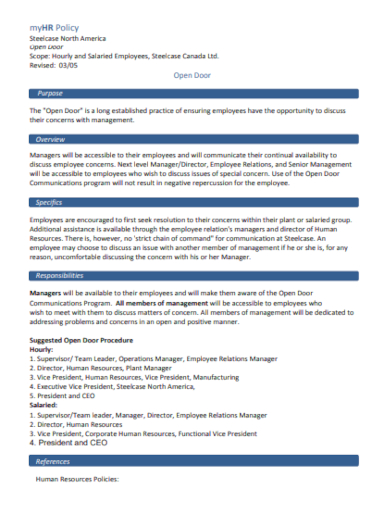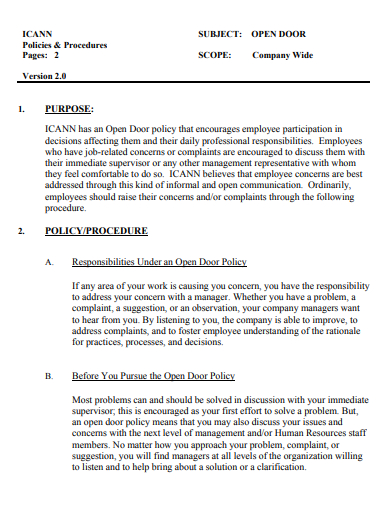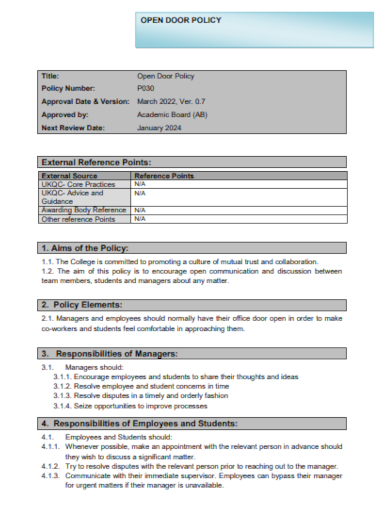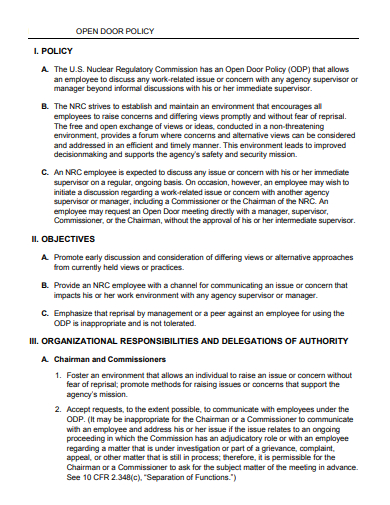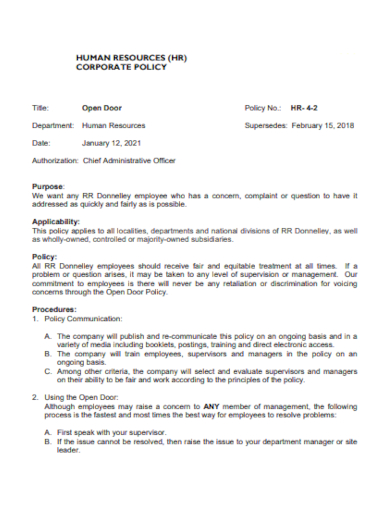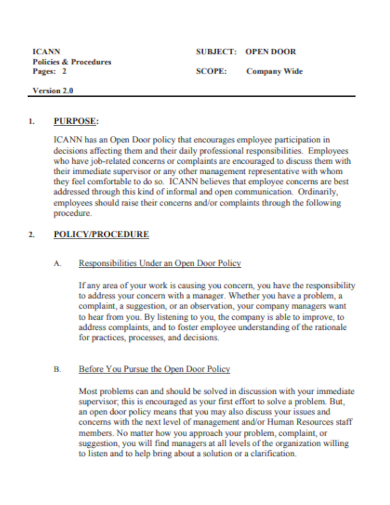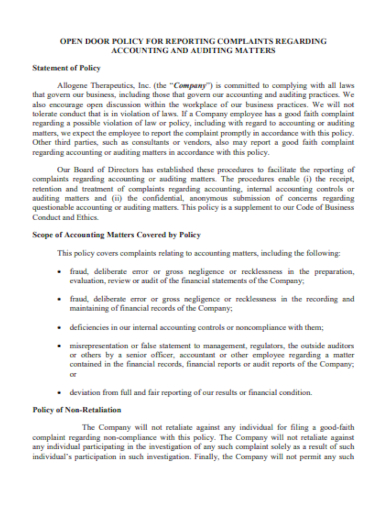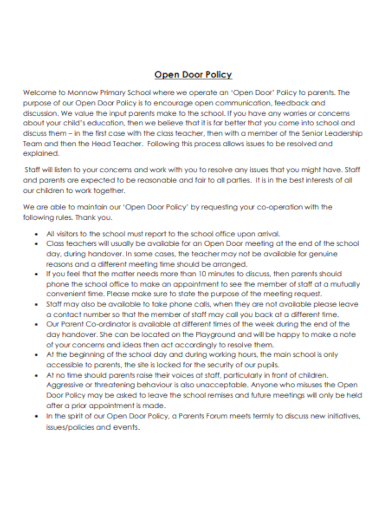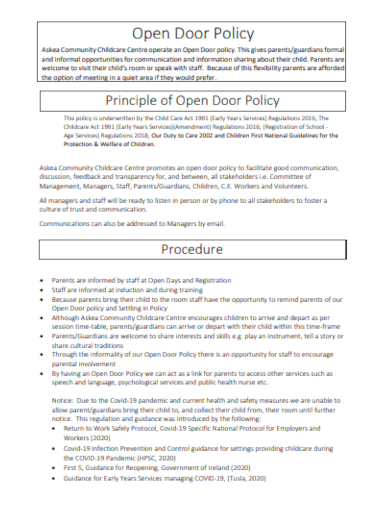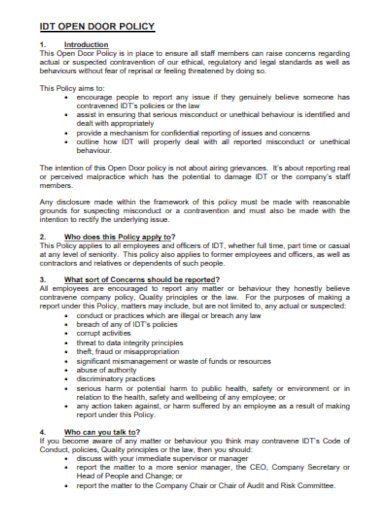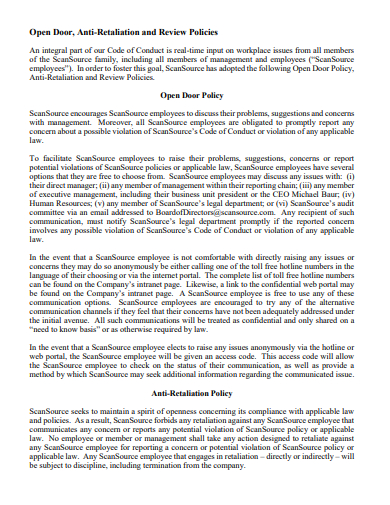Discover our comprehensive Open Door Policy template designed to foster transparency, trust, and communication within your organization. In today’s dynamic workplace landscape, open and honest dialogue is essential for success. Our Policy template provides a clear framework for employees and management to engage in constructive conversations, share concerns, and drive positive change. Implementing this Open Door Policy ensures that your workplace culture thrives, ultimately enhancing employee satisfaction and productivity. Download our template now to promote a more open and inclusive work environment.
20+ Open Door Policy Samples
1. Open Door Policy Template
2. Workplace Open Door Policy
3. Office Open Door Policy
4. Business Open Door Policy
5. Trade Open Door Policy
6. History Open Door Policy
7. Employee Open Door Policy
What is the Open Door Policy at work?
The Open Door Policy in the workplace is a fundamental approach to management and organizational culture that promotes transparency, communication, and accessibility between employees and their superiors, particularly within the hierarchical structure of a company. This policy encourages employees at all levels to feel comfortable expressing their thoughts, concerns, suggestions, and grievances, without the fear of retribution. It is a strategy designed to create a more inclusive, engaging, and productive work analysis environment.
At its core, the Open Door Policy signifies that the management or leadership of an organization is receptive to hearing from its employees. This means that employees can approach their managers, supervisors, or even top executives with their ideas, questions, or issues at any time. Whether it’s discussing career growth, work-related problems, innovative suggestions, or seeking guidance, the Open Door Policy ensures that the lines of communication are always open.
Here are some key aspects of the Open Door Policy:
Accessible Leadership: One of the primary features of this policy is that it makes leaders and management approachable. It breaks down the barriers between hierarchy levels, fostering a culture where employees are encouraged to reach out to their superiors without hesitation.
Transparent Communication: It promotes transparency in communication. When employees know they can openly discuss their concerns, it reduces misunderstandings, rumors, and fosters trust within the organization.
Conflict Resolution: The Open Door Policy provides a structured way to address conflicts or grievances. Employees can raise issues without fear, and managers can work on resolving them promptly and fairly, thus preventing larger issues from festering.
Idea Sharing: It encourages employees to share their ideas and suggestions for improvement. This can lead to innovation, process enhancements, and overall organizational growth.
Employee Engagement: By actively listening to employees, organizations can boost employee engagement and satisfaction. When employees feel heard and valued, they tend to be more committed to their work and the company’s goals.
Feedback Loop: It establishes a continuous feedback loop that benefits both employees and the organization. Regular feedback helps employees grow and develop in their roles, while organizations can make informed decisions based on this sample feedback.
To successfully implement an Open Door Policy, organizations should communicate its existence clearly to all employees. They should also ensure that managers and leaders are trained to handle various types of interactions that may arise under this policy, such as providing constructive feedback, addressing complaints, and respecting confidentiality.
The Open Door Policy is not just a mere policy but a powerful cultural tool that promotes open communication, employee empowerment, and a sense of belonging within an organization. When executed effectively, it can contribute to a more harmonious, productive, and forward-thinking workplace, benefiting both employees and the organization as a whole.
8. Open Door Policy Format
9. Manager Open Door Policy
10. Open Door Handbook Policy
11. Human Resources Open Door Policy
12. Open Door Policy Procedure
13. Complaint Reporting Open Door Policy
14. School Open Door Policy
Creating an Effective Open Door Policy
An Open Door Policy is a crucial component of a transparent and communicative workplace. It serves as a formalized structure for promoting open communication between employees and management. Here’s a step-by-step guide on how to craft an effective Open Door Policy:
1. Introduction:
Begin with a warm and inviting introduction. Explain why the Open Door Policy is essential and how it aligns with the organization’s values.
2. Statement of Commitment:
Clearly state the organization’s unwavering commitment to maintaining an Open Door Policy. Emphasize that all employees’ voices are valued and respected.
3. Policy Definition:
Provide a clear definition of what the Open Door Policy entails. Explain that it enables all employees, regardless of their position, to approach their superiors with concerns, ideas, feedback, or questions.
4. Applicability:
Define the scope of the policy by specifying who it applies to within the organization. Clarify whether it includes full-time, part-time, temporary employees, contractors, or consultants.
5. Accessibility of Leadership:
Highlight the approachability of leadership within the organization. Communicate that leaders are open and available to listen and engage in meaningful discussions.
6. Communication Channels:
Describe the various communication channels available to employees. These can encompass face-to-face meetings, scheduled office hours, email, phone calls, or dedicated feedback platforms.
7. Confidentiality Assurance:
Stress the importance of confidentiality when employees share their concerns or feedback. Assure employees that their information will be treated discreetly and respectfully.
8. Conflict Resolution Framework:
Explain how the Open Door Policy handles conflict resolution. Outline the steps that will be taken to address and resolve issues brought forward by employees.
9. Non-Retaliation Commitment:
Explicitly state that employees are protected from any form of retaliation for using the Open Door Policy. Ensure that employees feel secure in expressing their concerns without fear of adverse consequences.
10. Training and Awareness:
Mention any training programs or resources available to help employees and managers effectively use the policy. This could include conflict resolution training or communication workshops.
11. Feedback Mechanism:
Establish a feedback mechanism for employees to provide input on the effectiveness of the Open Door Policy. Demonstrate the organization’s dedication to continuous improvement.
12. Periodic Review and Revision:
Indicate that the policy will undergo periodic reviews and updates to ensure it remains relevant and effective in meeting the evolving needs of the organization.
13. Conclusion:
Conclude with a summary of the key points, reiterating the organization’s commitment to open communication, trust-building, and fostering a positive work environment.
14. Signature and Date:
Include a designated space for the signature of organizational leadership or an HR representative, along with the date of policy approval.
15. Distribution:
Explain how the policy will be distributed to all employees. This can involve posting it on the company’s intranet, sending it via email, or providing printed copies.
16. Training and Orientation:
Consider conducting training sessions or orientations to ensure that all employees are aware of the Open Door Policy and understand how to utilize it effectively.
17. Accessibility:
Ensure that the policy is easily accessible and prominently displayed in the workplace, so employees can refer to it when needed.
Remember, an Open Door Policy is more than just a document; it’s a commitment to cultivating a culture of open communication and trust. Continuously reinforce this culture through leadership actions and consistent adherence to the principles outlined in the policy.
15. Open Door Policy Document
16. Sample Open Door Policy
17. Community Open Door Policy
18. Basic Open Door Policy
19. Standard Open Door Policy
20. Open Door Activity Policy
21. Open Door Review Policy
What are the components of an open door policy?
An effective Open Door Policy is a vital aspect of fostering transparency, communication, and employee engagement within an organization. It serves as a framework for employees to freely voice their concerns, ideas, and feedback. Here are the key components of a comprehensive Open Door Policy:
1. Purpose and Introduction:
Start with a clear and concise introduction that explains the purpose of the policy. Highlight the importance of open communication, trust-building, and the organization’s commitment to listening to its employees.
2. Statement of Commitment:
Declare the organization’s unwavering commitment to maintaining an Open Door Policy. Emphasize that all employees are encouraged to participate, and their input is valued.
3. Policy Definition:
Provide a precise definition of what the Open Door Policy entails. Explain that it grants employees, regardless of their position, the opportunity to approach their superiors with concerns, suggestions, questions, or issues.
4. Applicability:
Define the scope of the policy by specifying who it applies to within the organization. Clarify whether it includes full-time employees, part-time employees, temporary staff, contractors, or consultants.
5. Accessible Leadership:
Highlight the accessibility of organizational leadership. Communicate that leaders, including managers and executives, are open and available to listen and engage in constructive discussions with employees.
6. Communication Channels:
Describe the various communication channels available to employees. These channels may include in-person meetings, scheduled office hours, email, phone calls, suggestion boxes, or dedicated feedback platforms.
7. Confidentiality Assurance:
Stress the importance of confidentiality when employees share their concerns or feedback. Assure employees that their information will be treated discreetly and will not be disclosed without their consent.
8. Conflict Resolution Framework:
Explain how the Open Door Policy handles conflict resolution. Outline the steps that will be taken to address and resolve issues brought forward by employees, emphasizing fairness and impartiality.
9. Non-Retaliation Commitment:
Clearly state that employees are protected from any form of retaliation for using the Open Door Policy. Ensure employees feel secure in expressing their concerns without fear of adverse consequences.
10. Training and Awareness:
Mention any training programs or resources available to help employees and managers effectively use the policy. This may include conflict resolution training, communication workshops, or educational materials.
11. Feedback Mechanism:
Establish a feedback mechanism for employees to provide input on the effectiveness of the Open Door Policy. Demonstrate the organization’s commitment to continuous improvement and adaptability.
12. Periodic Review and Revision:
Indicate that the policy will undergo regular reviews and updates to ensure it remains relevant and effective in meeting the evolving needs of the organization and its employees.
13. Conclusion:
Conclude with a summary of the key points, reiterating the organization’s commitment to open communication, trust-building, and fostering a positive work environment.
14. Signature and Date:
Include a designated space for the signature of organizational leadership or an HR representative, along with the date of policy approval.
15. Distribution:
Explain how the policy will be distributed to all employees. This may involve posting it on the company’s intranet, sending it via email, or providing printed copies during orientations.
16. Accessibility:
Ensure that the policy is easily accessible and prominently displayed in the workplace, so employees can refer to it when needed.
A well-structured Open Door Policy helps create a culture of openness, trust, and collaboration, ultimately benefiting both employees and the organization as a whole. It encourages employees to actively participate in the improvement and success of the organization by providing a platform for their voices to be heard and valued.
Related Posts
FREE 10+ Suspension And Expulsion Policy Samples in MS Word | PDF
FREE 10+ Student Travel Policy Samples in MS Word | Google Docs | Pages | MS Outlook | PDF
FREE 10+ Uniform Complaint Policy and Procedure Samples in PDF
FREE 10+ Bullying Policy Samples in MS Word | PDF
FREE 10+ Fiscal Control Policy Samples & Templates in MS Word | PDF
FREE 10+ Cooperative Policy Samples & Templates in MS Word | PDF
FREE 10+ Disenrollment Policy Samples in MS Word | PDF
FREE 10+ Donation Policy Samples & Templates in MS Word | PDF
FREE 10+ Homework Policy Samples & Templates in MS Word | Pages | PDF
FREE 10+ IT and Software Policy Samples in PDF | MS Word | Pages | Google Docs
FREE 50+ Policy Samples in PDF | MS Word
FREE 50+ Membership Policy Samples in PDF
FREE 10+ Shipping Policy Samples in PDF
FREE 10+ Expense Policy Samples in Word | Google Docs | Pages | PDF
FREE 10+ Website Policy Samples in PDF | MS Word | Pages | Google Docs | Outlook

